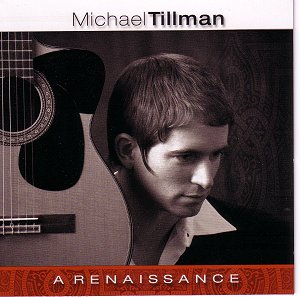Michael Tillman is a young Texan, who
is self taught as a guitarist, having
learnt to transcribe pieces to tablature
from recordings by Segovia, Yepes and
Julian Bream. He studied architecture
for three years but having given this
up after three years devoted himself
to the guitar full-time. This is his
debut CD and is to be followed by a
Christmas album and a disc with French
and Spanish music. His musical tastes
are catholic, covering all periods and
styles, even flamenco and jazz.
The present disc contains
16th century compositions,
originally written for lute or vihuela,
which was a forerunner to the present-day
guitar. Mr Tillman has himself transcribed
the pieces here (thirty in all) to suit
the six-stringed guitar. There are primarily
three common types represented, which
Dr. James Wintle points out in his informative
liner notes: virtuoso pieces, dance
music and transcriptions of songs. Mixing
these three types intelligently produces
a well-balanced and varied programme,
which makes the disc attractive to listen
to, also in larger doses, even though,
generally speaking, discs of this kind
are even better appreciated a few pieces
at a time. Beginning and ending the
recital with possibly the greatest vihuela-composer
of the late renaissance, Luis Milan,
and also placing three of his pavanas
in the middle of the recital. There
is then a sprinkling of pieces by the
most important lutenist of the period,
John Dowland to give the programme back-bone.
To modern ears, spoilt by listening
to music with wider dynamics and advanced
harmonic language, most music before
c. 1600 can seem small-scale and even
impersonal. Pricking up the ears and
listening closely, preferably with headphones,
which I regularly do, the supposedly
small-scale landscape can turn out to
be filled with attractions. The technical
demands – if that implies a certain
number of notes to be played per minute
– are fairly modest but music making
rarely has anything to do with who plays
fastest or shouts loudest. What we can
admire and enjoy is the fine detail,
the nuances, the affection and the consistency
of both the compositions and the physical
music-making. It is all very stylish
and warmly inviting – a well-needed
counterpoint to the terror, the catastrophes
and the turmoil in the world around
us. And there are several individual
pieces that make us sit up and say:
"Ah! That’s interesting!" Let me pick
a few things that I jotted down on my
note-pad:
After the first three
Milan pieces, which felt a bit anonymous,
the Saltarello (track 4) by an anonymous
composer, felt very personal. Dance
music it certainly is and with its drone
and relentless forward drive, I felt
this could very well have been performed
on a bag-pipe. Morlaye’s Galliard (track
9) is delicately syncopated and Mudarra
spices his Fantasia (track 12) with
some dissonances, which a present-day
listener probably reacts more to than
his contemporaries did. Several of the
song transcriptions with their suggestive
titles make the listener create mental
pictures and imagine characters and
actions.
Just one nagging point:
Why do so many designers persist in
having liner notes and other important
information in white on black? Everybody
should know by now that this considerably
diminishes the readability – and notes
are intended for reading, aren’t they?
Apart from that this
is a fine disc and a worthy debut for
Michael Tillman. I shall be very interested
to hear him in some other repertoire,
which also might be of more general
interest. Renaissance music is still
very much a specialists’ field, but
anyone interested in good guitar playing
will derive a lot of pleasure from the
present disc and possibly find a new
niche in music history to delve into.
And there are riches!
Göran Forsling


